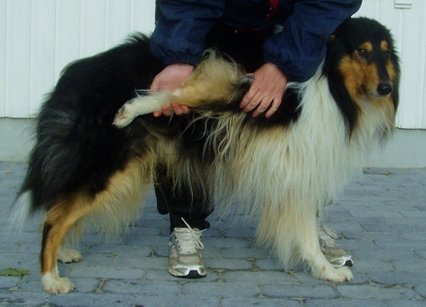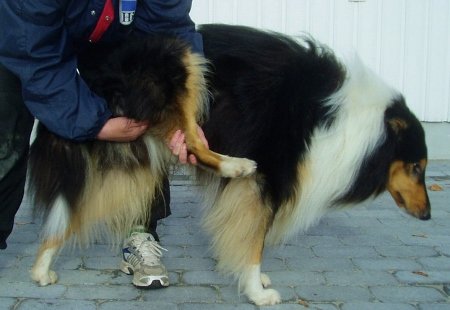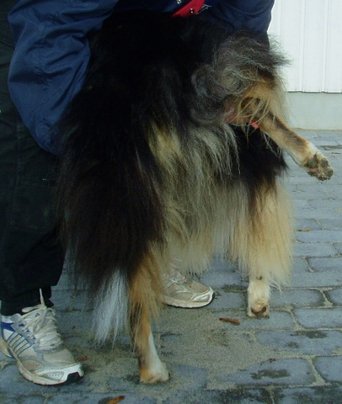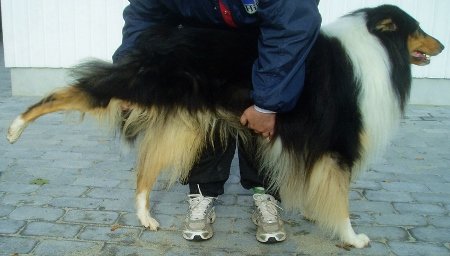STRETCHING
What is stretching?
Stretching (and of course daily physical and psychic activity) is a great natural tool to improve the well-being and longevity of your dog. It takes just a few minutes a day and do wonders.
Stretching involves slow and determined lead an extremity against a predetermined maxposition and hold this position for 15 seconds. Before you are able to stretch the muscles/joints to the max it can take some weeks. This means that when one starts to stretch the dog might get just halfway to the maxposition. Stop when you notice a resistance and hold that position for 15 seconds. After a while you will be able to bend/stretch to the optimum position.
Pictures show TengelMan -
BH NCH (NHL) Echuca Dynamite Delinquent Tengel
Position 1:
Stretching the shoulder flexors. Gentle move the stretched front leg forward and upward to the
position is optimal as 90 degrees to the surface. Stay next to your dog, grasp the elbow from the inside and gentle lead the leg forward and upward. At the point of resistance, stop and hold the position for 15 seconds,
and repeat 2-4 times on each front leg.
Of course the dog should not show any type of sign
that he/she is in pain or discomfort. To reach the
optimal position it requires stretching 1-2 times a
day for about 1-3 months. This movement is very important; training the triceps muscles, where some sports-injuries occur. It also improve the integrity of shoulder structure (benefits wrist and elbows) and increase the dogs breathing capacity.
Position 2:
Stretching the chest area. This is an abduction stretch, meaning a stretch away from center. Grasp around the elbow, the leg should be slightly bent. Hold the position for about 15 seconds, and repeat 2-4 times. The optimal position is approximately 90 degrees
Position 3:
Stretching the front-legs muscles and part of the neck muscles Grab hold of the wrist and lead the leg backward so that the paw, in optimal position, is close to the hip bone. Hold the position for about 15 seconds and repeat 2-4 times
Position 4:
Stretching the back-legs to increase flexibility in hips, thighs and spine.
Stabilize the hip with one of your hands
and grab the back-leg with the other and straighten the leg forward guiding the stifle to straighten. Continue to stretch until you feel a slight resistance.
Hold for 15 seconds, and repeat 2-4 times.
It can take up to 6 months or even 1 year to accomplish the optimal position which is the
back-leg parallel with the elbow-joint
Position 5:
Stretching the muscles on the inside of the thigh. The optimal position is approximately 90 degrees out from the dog's side. Should you notice any pain in this position it can indicate problems with the hips (you go to the veterinarian to check it out). Grab the knee-joint and gentle move the leg out from the body – like when you see a male dog pee. Stretch until you feel a resistance and hold for 15 second, repeat 2-4 times.
Position 6:
Stretching the hip flexors which are
muscles that enable your dog to move his
legs and hips while walking. This also shows
the movement most dogs do when they
perform their morning gymnastics. Grab
the back-leg just above the knee, and allow
the dog to stretch out the leg till the
optimum position in principle is right out
in the horizontal plane from the dog.
When you can feel some resistance
then stop and hold the position for
15 seconds, and repeat 2-4 times.
It will improve the condition in the lower
back, hip and leg-muscles. It can also
reduce arthritis related pain
Stretching rules:
* It might take 1-2 weeks to learn a dog to stretch
* The dog should be standing or laying down
* The dog should be warming up before stretching (=warm) which involve a trip for
about 15-20 minutes
* Stretch always after achievements/training, when the dog is relaxed
* The dog should not feel pain or discomfort when stretching
* Stretch within 30 minutes after a walk
* Stretch at least once a day
* If the dog is under treatment/rehabilitation you are of course cooperating with
your veterinarian. You also contact your veterinarian if the dog show pain
* The goal is that all four legs should be able to be bent to the optimal position
Good luck – your dog will thank you





